

Indigenous Australians. Introduction to Indigenous Australia - Australian Museum. Australia has always had a mix of cultures and people although not in the same way as it does today.
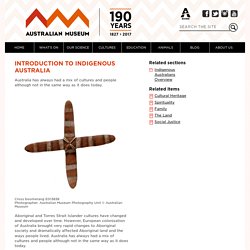
Cross boomerang E013838 Photographer: Australian Museum Photography Unit © Australian Museum Aboriginal and Torres Strait Islander cultures have changed and developed over time. However, European colonisation of Australia brought very rapid changes to Aboriginal society and dramatically affected Aboriginal land and the ways people lived. Australia has always had a mix of cultures and people although not in the same way as it does today. Before 1788 Australia was populated only by the Indigenous people of Australia - Aboriginal and Torres Strait Islanders. Before 1788 there were approximately 700 languages spoken throughout Australia with an estimated population of 750 000 people.
In many ways Indigenous Australia was different in the past from what it is today. Indigenous people lived a hunter and gatherer life. Australia's first people, Australia before the British arrived, British colonisation of Australia, SOSE Year 4, NSW. Early Australia Australia has not always looked like it does today.

Before 1788 the only people living in Australia were Aboriginal people and Torres Strait Islander people. There were no buildings and no roads like there are today. The environment was also very different. Indigenous Weather Knowledge - Sub divisions within the key climate groups. Desert Knowledge for Kids - Alice Springs Desert Park. D'harawal calendar - Indigenous Weather Knowledge - Bureau of Meteorology. D'harawal calendar D'harawal The D'harawal Country and language area extends from the southern shores of Port Jackson (Sydney Harbour) to the northern shores of the Shoalhaven River, and from the eastern shores of the Wollondilly River system to the eastern seaboard.
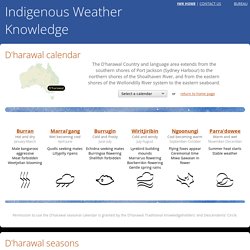
Permission to use the D'harawal seasonal calendar is granted by the D'harawal Traditional Knowledgeholders' and Descendents' Circle. D'harawal seasons Navigate back up to the calendar overview with the links at the end of each season. Time of Burran January-March Gadalung Marool—hot and dry Gymea lily by Mark Wilgar The behaviour of the male kangaroos becomes quite aggressive in this season, and it is a sign that the eating of meat is forbidden during this time. The blooming of the Weetjellan (Acacia implexa) is an important sign that fires must not be lit unless they are well away from bushland and on sand only, and that there will be violent storms and heavy rain, so camping near creeks and rivers is not recommended.
Calendar A Brief Aboriginal History. “The very ink with which all history is written is merely fluid prejudice.”

Mark Twain Since the European invasion of Australia in 1788, the Aboriginal people have been oppressed into a world unnatural to their existence for thousands of years. First came the influx of the strangers who carried with them diseases, which decimated the immediate population of the Sydney tribes. It is estimated that over 750,000 Aboriginal people inhabited the island continent in 1788.
The colonists were led to believe that the land was terra nullius (‘no one’s land’), which Lt James Cook declared Australia to be in 1770 during his voyage around the coast of Australia. “… they were so ignorant they thought there was only one race on the earth and that was the white race. It would not be an exaggeration to claim that the Island continent was owned by over 400 different nations at the time of this claim by Cook.
Australians Together. Connection to Country For many Indigenous people, land relates to all aspects of existence - culture, spirituality, language, law, family and identity.
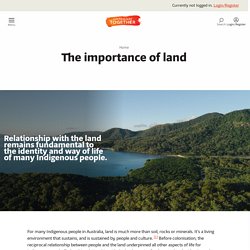
Rather than owning land, each person belongs to a piece of land which they’re related to through the kinship system. That person is entrusted with the knowledge and responsibility to care for their land, providing a deep sense of identity, purpose and belonging. Why a connection to country is so important to Aboriginal communities. Trying to frame this concept in modern language, is like trying to grasp a two dimensional cup out of a piece of paper, it's the layers that make the cup palpable, not the drawing of it.
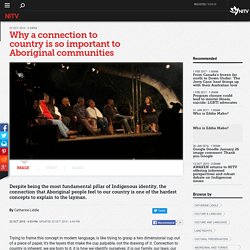
Connection to country is inherent, we are born to it, it is how we identify ourselves, it is our family, our laws, our responsibility, our inheritance and our legacy. To not know your country causes a painful disconnection, the impact of which is well documented in studies relating to health, wellbeing and life outcomes. Modern constructs of identification do not work for us, in fact they dismantle the fabric that holds us together. For example, it matters not that my licence says that I live in Sydney, it matters that I am guest in this place, I respect it because I am from the Arrente and Luritja lands, and it is this knowledge that enables me to identify who I am, who my family is, who my ancestors were and what my stories are.
What if I told you I can travel through time and worlds? Meaning of land to Aboriginal people - Creative Spirits. What does land mean to Aboriginal people?
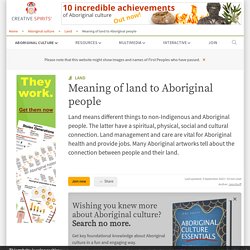
Non-Indigenous people and land owners might consider land as something they own, a commodity to be bought and sold, an asset to make profit from, but also a means to make a living off it or simply 'home' . They 'develop' land, as if it was unfinished or raw. For Aboriginal people the relationship is much deeper. Palyku woman Ambelin Kwaymullina explains: "For Aboriginal peoples, country is much more than a place. They have a profound spiritual connection to land. The health of land and water is central to their culture. Key take-away: The land owns Aboriginal people and every aspect of their lives is connected to it. Living in a city has its own challenges. We cultivated our land, but in a way different from the white man. The Lost Girl The girl had lost her way. The girl wandered, alone.